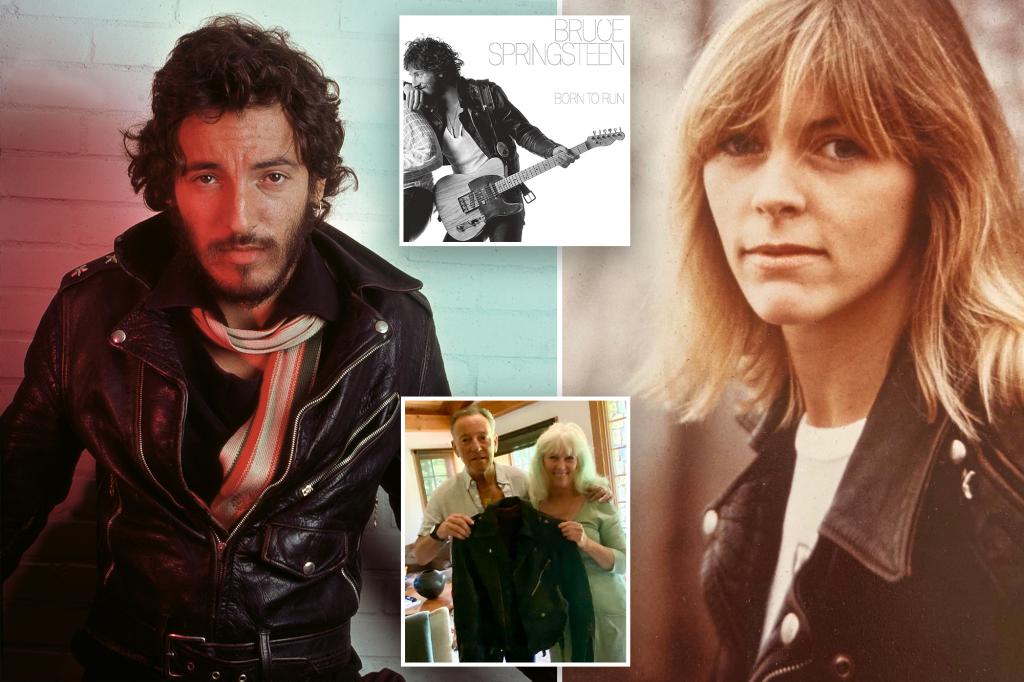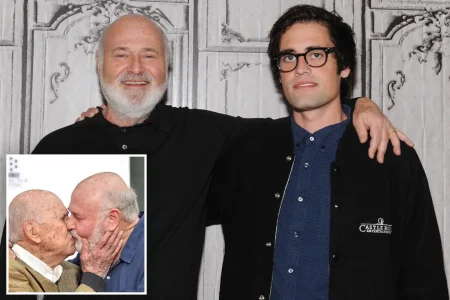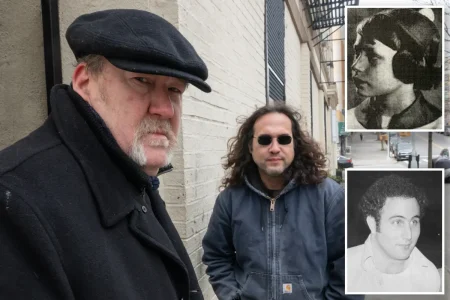The Untold Story of Bruce Springsteen’s Iconic “Born to Run” Jacket
In the summer of 1975, on a typical New York City day, a pivotal moment in rock history unfolded when 25-year-old Bruce Springsteen tried on an old leather motorcycle jacket that belonged to his manager, Mike Appel. The jacket, which Appel had received as a 16th birthday gift back in 1958, fit Springsteen “like a glove.” With those simple words—”This is it”—Springsteen claimed the jacket as his own and headed downtown with saxophonist Clarence Clemons to create what would become one of rock’s most iconic album covers. With the battered black leather coat adorned with silver star studs on his back and his Telecaster in hand, Springsteen posed for the cover of “Born to Run,” unknowingly creating a lasting image that would help define his career and a specific era of American rock and roll. What few people knew was the remarkable journey this jacket would take over the following decades—a journey that remained a mystery to fans until recently.
The story of the jacket begins well before Springsteen ever wore it. In 1958, Mike Appel was a teenager from Queens with rock and roll aspirations when he asked his mother for a black leather jacket for his 16th birthday. Like many young men of his generation, Appel was influenced by rebel icons like Marlon Brando, James Dean, Elvis Presley, and Gene Vincent. “I was wanting to be a little bit of a rock ‘n’ roll bad boy,” Appel recalled. “That jacket became something to have—you were part of that world too. It was your way of showing that. And you thought you might attract women with it.” His mother took him to a local Robert Hall clothier near the Queens-Nassau line, where he selected a leather jacket with red lining. Though often assumed to be a Schott NYC brand jacket (favored by rockers like the Ramones), experts believe it was likely a generic steerhide model from the same manufacturer that produced leathers for Montgomery Ward. Appel wore the jacket throughout his rebellious youth until his father convinced him to attend college, after which the jacket was “stuffed somewhere” and forgotten for years.
Fast forward to the early 1970s, when Appel, now working as a songwriter and producer, was introduced to an overlooked 22-year-old musician from Freehold, New Jersey—Bruce Springsteen. Recognizing Springsteen’s immense talent, Appel secured him an audition with Columbia Records, which led to a contract. After two commercially unsuccessful albums, Springsteen and his band poured everything into making “Born to Run” their breakthrough. After fourteen months of intensive work (including six months on the title track alone), the album was nearly complete by June 1975, and it was time to photograph the cover. That’s when Springsteen—always particular about his image—asked Appel about the old motorcycle jacket he’d mentioned wearing as a teenager. When Springsteen put it on, the decision was instantaneous. “He puts it on, he takes one look, and said ‘I’m doing this, I’m going off for my photos.’ And that was it,” Appel remembered. “It symbolized the same things it did for me. It was rebellion. Life is not always happy. It can be dark, too. And our fathers would never be caught dead in one of those jackets, so we wanted one.” Springsteen even added a small Elvis button he picked up at a souvenir shop on his way to the photo session, further personalizing this symbol of rock rebellion.
The jacket became Springsteen’s signature look throughout the “Born to Run” tour, helping him embody the characters from songs like “Jungleland,” “Night,” and “Backstreets” on stage. He continued wearing it even as his relationship with Appel deteriorated into a bitter legal battle by summer 1976. Then, in October of that year, Springsteen was seen leaving NYC’s Palladium Theater wearing the jacket, signing a few autographs before climbing into a car and waving goodbye. After that night, the iconic jacket mysteriously vanished from public view. When Appel and Springsteen reconciled nearly a decade later, Appel asked what had happened to his old coat. Springsteen’s response was simple and honest: “I gave it to a girl. But you know, you would have done the same thing.” This casual admission sparked decades of speculation among fans about which of Springsteen’s girlfriends from that era might have received the famous jacket. Was it ballerina Karen Darvin, who was known to wear it offstage during the tour? Or perhaps rock photographer Lynn Goldsmith? Maybe actress Joyce Hyser? The mystery persisted until the jacket unexpectedly appeared at the Rock and Roll Hall of Fame in 2010, with no disclosure about who had loaned it.
The truth finally emerged: the jacket had been given to Joy Hannan, a young woman from New Jersey whom Springsteen met at the Stone Pony in Asbury Park in 1976. “It’s not a secret that I had the jacket,” Hannan told The Post. “I used to wear it when we were dating.” They met when Springsteen was in the thick of his lawsuit troubles with Appel, during a period when he was unable to record music. The Stone Pony had become his refuge, a place where he could remain “just a guy in a band.” Hannan was in her early 20s and had just graduated college when Springsteen asked her to dance, gave her his phone number, and asked her to call him. During their relationship, Springsteen frequently placed the “Born to Run” jacket on her shoulders until one day he told her to keep it. “He liked me to wear it when we were out,” Joy recalled. “He gave it to me because he said I looked better in it than he did.” By spring 1977, when Springsteen and Appel settled their lawsuit and the E Street Band returned to the studio to record “Darkness on the Edge of Town,” Springsteen’s focus shifted back to music. He and Joy gradually drifted apart, but he never asked for the jacket back.
For decades, Joy kept the iconic jacket safe in a cotton garment bag in her closet as she built a life away from the rock and roll spotlight. She got married, had children, and moved eight times across different states, always keeping the jacket with her. The jacket was already in poor condition when Bruce gave it to her—his friend Obie Dziedzic had once replaced its ragged red lining—so Joy rarely wore it. Despite its extraordinary value (experts estimate it could fetch over $1 million at auction), Joy never seriously considered selling it, even when her husband suggested it could help them buy a house. She and Springsteen remained friendly over the years, and she would occasionally attend his concerts where he would take her and her family backstage. At one show, she even wore the jacket so Bruce could see she still had it. It was Joy who first loaned the jacket to the Rock and Roll Hall of Fame in 2010. Finally, in June 2022—just before “Born to Run’s” 50th anniversary—Joy decided “it was time for it to go someplace better than my closet.” She drove to Springsteen’s home in Colts Neck and personally returned the jacket to him. They took a photo together holding the iconic coat, which now hangs once again in the Rock and Roll Hall of Fame. When asked about the jacket, Appel, whose mother paid around $30 for it in 1958, dismissed any suggestion that it belonged to anyone but Springsteen: “He earned that one. I never did a four-hour show in my life. Except when I was doing the sound and lights for him. What, are you kidding?”











